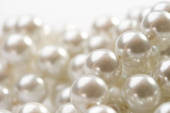|
 Pearls are the world’s only cultured organic gemstone. They have been around since the 19th
century and have such a classic and beautiful elegance that they have remained a desirable option for jewelry
still today. When deciding on an investment, it is helpful following a simple guide to buying pearls in order
to insure value. There are two main varieties of cultured pearls: saltwater pearls and freshwater pearls. Pearls are the world’s only cultured organic gemstone. They have been around since the 19th
century and have such a classic and beautiful elegance that they have remained a desirable option for jewelry
still today. When deciding on an investment, it is helpful following a simple guide to buying pearls in order
to insure value. There are two main varieties of cultured pearls: saltwater pearls and freshwater pearls.
Saltwater Pearls
These pearls come from exotic locations such as Akoya, Tahitian and the South Sea. They are also grown in bays,
inlets and atolls. These are considered more valuable than freshwater pearls.
Akoya pearls were the very first culture pearls in history. The Akoya oyster from which they come is smaller
than other pearl oysters and produced in Japan or China.
Tahitian pearls are considered to be the most valuable. This is because they are the only pearl able to be
graded which is handled by the French Polynesian government.
South sea pearls are often the largest cultured pearls on the market. These come from either the silver lipped
or gold lipped oyster. Generally you may find the gold lipped pearls in Indonesia and they will consist of a more
cream and yellow coloring. The silver lipped pearls can be found in Australia.
Freshwater Pearls
Freshwater pearls are culture in mussels found primarily in china, Japan and America. They are usually grown in
man made lakes and reservoirs. Although they are not considered as valuable as the saltwater counterparts, there
are many rate and very high quality freshwater pearls which are exceptional and therefore highly valuable. Many
pearl manufacturers in China have recently switched from a production of quantity to quality making freshwater
pearls competitive with salt.
Grading Pearls
 Unfortunately there is not a true standard system for grading pearls. The
Tahitian pearl has a system stipulated by the French Polynesian government for export.
Each company will have its own system for grading their pearls based on surface, shape and
color. The luster of a pearl can range from Poor to Excellent and range from a clean
surface to a blemished surface to anything in between. Unfortunately there is not a true standard system for grading pearls. The
Tahitian pearl has a system stipulated by the French Polynesian government for export.
Each company will have its own system for grading their pearls based on surface, shape and
color. The luster of a pearl can range from Poor to Excellent and range from a clean
surface to a blemished surface to anything in between.
Size can be a factor as well as shape. The more round the pearl the better quality.
Understanding where the pearls originated will help you to determine the quality of the pearl
as well. If they are man made they will most likely be of less value. On occasion you may find
the rare, flawless pearl which is a freshwater candidate and of high esteem. An experienced
expert or jeweler should be able to substantiate this claim.
Pearls also range in color and some are rarer such as the black pearl. There are many other
shades including: white, peach, pink, cream, gold, rose or purple tones. The classic white or
ivory are most popular since they became popularized by high society types in earlier
history.
Using this guide to buying pearls should give you an edge on your investments. Always be
sure to validate claims made by companies who are claiming to have a rare pearl which is not a
salt water variety.
|
| 

 Pearls are the world’s only cultured organic gemstone. They have been around since the 19th
century and have such a classic and beautiful elegance that they have remained a desirable option for jewelry
still today. When deciding on an investment, it is helpful following a simple guide to buying pearls in order
to insure value. There are two main varieties of cultured pearls: saltwater pearls and freshwater pearls.
Pearls are the world’s only cultured organic gemstone. They have been around since the 19th
century and have such a classic and beautiful elegance that they have remained a desirable option for jewelry
still today. When deciding on an investment, it is helpful following a simple guide to buying pearls in order
to insure value. There are two main varieties of cultured pearls: saltwater pearls and freshwater pearls. Unfortunately there is not a true standard system for grading pearls. The
Tahitian pearl has a system stipulated by the French Polynesian government for export.
Each company will have its own system for grading their pearls based on surface, shape and
color. The luster of a pearl can range from Poor to Excellent and range from a clean
surface to a blemished surface to anything in between.
Unfortunately there is not a true standard system for grading pearls. The
Tahitian pearl has a system stipulated by the French Polynesian government for export.
Each company will have its own system for grading their pearls based on surface, shape and
color. The luster of a pearl can range from Poor to Excellent and range from a clean
surface to a blemished surface to anything in between.